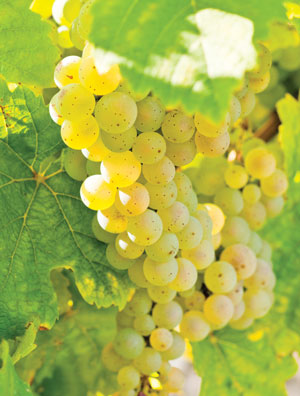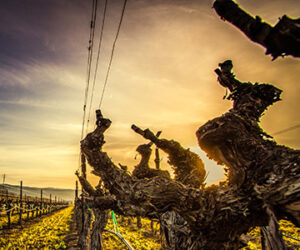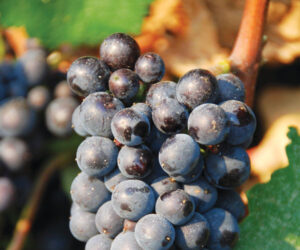 My experience with making wine from Riesling goes back almost 20 years. In fact, the first white wine I ever made was from Riesling grapes — they were free if I picked them myself. I remember that it was a beautiful fall day and the fruit was in great condition. Unbeknownst to me, though, was the sensitivity of the property owner, who was not quite ready to hear me describe petroleum and diesel qualities when I tasted his wines.
My experience with making wine from Riesling goes back almost 20 years. In fact, the first white wine I ever made was from Riesling grapes — they were free if I picked them myself. I remember that it was a beautiful fall day and the fruit was in great condition. Unbeknownst to me, though, was the sensitivity of the property owner, who was not quite ready to hear me describe petroleum and diesel qualities when I tasted his wines.
As it turns out, those diesel-y wines were actually very true to style of Riesling. They were perhaps a bit young to have those characters, but with some tweaks, that winemaker would have had some wines that could age fantastically with Old World style. It was a good thing the fruit was already loaded on to the truck when that owner and I butted heads, because in the end I was almost run off the property!
To this day, I consider that Riesling vintage one of the best wines I ever made, and I wish I could find a bottle or two in my cellar to taste what I had predicted to be a very graceful aging wine. Unfortunately, my wine suffered from a case of the “toos.” It was too good and it went too fast. Also unfortunately, I don’t think that Riesling vineyard exists any longer. I recognized that owner some years later snagging up cuttings of Sangiovese in another vineyard I was pruning. When I asked my boss about the man, my boss replied that the man said he was going to bud over a Riesling vineyard because he didn’t like the flavors. Sadly, that Riesling grower had a goldmine — he just didn’t know how to maximize its potential.
Riesling is a cool weather-loving grape that does not do well in warm climates. As such, it has huge success in northern latitudes. The berries are small, the clusters are tight, and under the right conditions they are subject to the “noble rot” Botrytis. In sunnier and warmer regions, the viticulturist must work to shade the fruit to prevent sunburn. In the literature about the varietal, you will read that Riesling grapes produce wines with floral notes, green apple, pear, juniper, lime, lychee nut, guava, honeysuckle and an often confusing reference to “mineral.” (I must defer to my colleagues at UC-Davis on further definition of the term “mineral,” as it’s not a term that I was introduced to in sensory science and I do not capture the true essence of it.) As mentioned in the opening paragraph, petroleum — or petrol — is a flavor descriptor true to Riesling, and some of the best Riesling wines in the world possess this quality.
Chemically, that petrol quality is caused by the compound 1,1,6-trimethyl-1,2-dihydronaphthalene (TDN), which is created from terpenes by acid hydrolysis during the aging process. Terpenes are a broad class of organic compounds most notable for volatile aromas. Some familiar examples of terpenes are the aromas from turpentine (hence the name), some of the aromas in hops as well as those alternative medicine compounds used in aromatherapy. In wine, terpenes give floral notes, or that of linalool, which has also been described as the flavor from the Fruit Loops breakfast cereal. Wines have more of a tendency to form TDN from ripe grapes, which can be the result of low yields or late harvest dates, high light exposure in the vineyard, water stress or gravelly soils.
In the case of my first experience with Riesling, the vineyard was trained on vertical shoot positioned trellis resulting in high light exposure. The cellar where the wines were aged was also a bit on the warm side, which resulted in premature aging of the fermentation bouquet characters, accentuating the petrol note. Too much petrol can be a negative contribution, as was the case in my host’s wines. More shading of the fruit and selecting an earlier harvest date, in addition to improved temperature control in the cellar would have greatly enhanced his wines.
The grape and the wines it makes are complex. Granted, this seems trivial, but let’s start with how it is spelled and the grape’s origins. You will find the grape spelled r-e-i-s-l-i-n-g and r-i-e-s-l-i-n-g. In school we learned the phrase “i before e except after c.” The name Riesling is shortened from the German word Riesslingen, however, and those spellings of “Reisling” are anglicized versions of this word with German origins.
Riesling was first recorded in history in the first century A.D., but it wasn’t until the 15th century that the grape began to receive more notoriety. The first Reisling plantings were recorded in the Rheingau region of Germany. The planting later spread to the Mosel River Valley and then into the Alsace region of France under the name Rissling. These plantings consisted of Riesling mostly as a component in field blends with other local grapes. The first vineyard planted with 100% Riesling was that at the Schloss Johannisberg in the Rheingau in 1716, giving rise to the term Johannisberg Riesling. Some may remember this term being used on domestic jug wine labels of the 1970s and 1980s. In this case, however, it was a brand name and had no relation to the original name, other than the name itself.
The grape enjoyed great notoriety in the 19th century, often usurping the grand crus of Bordeaux and Burgundy. Alas, the Great War of 1914–1918 and World War II devastated the vineyards of the Rheingau and Mosel regions, and after the wars the vineyards were replanted with not just Riesling, but also Sylvaner and Müller Thurgau, which were known for higher yields. Much of the exported German wines of the 1970s and 1980s incorporated these varieties, and Riesling was only a small component. In the mid-1990s there was a return to quality, and now many of the vineyards of the Rheingau and Mosel are once again comprised primarily of Riesling. When explored on a local level, you will find that the wines from these vineyards are quite exceptional in quality and vary in style.
Today, on a global scale, Riesling is planted in the Alsace region of France, Austria, South America, New Zealand, Australia, North America and South Africa. The best successes with these plantings are the cooler regions. The New York Finger Lakes region, for instance, produces many fine examples, both from actual vines, or descendants of vines, brought to the region by original German settlers. Just to the north, in Canada, Riesling is a principle component in the ice wines of Quebéc and Ontario. It is also blended with Vignoles and Vidal Blanc. In California, the best examples are from the Anderson Valley appellation on the north coast. In Washington State, Chateau Ste. Michelle mass produces the brand Eroica, a German-style Riesling, that they developed by partnering with Dr. Ernest Loosen, a well-known German winemaker from the Mosel Valley.
The classic styles of Riesling are most easily explained with the help of the German Prädikatswein classification scheme. As is the case in many of the world’s famed wine growing regions, the climate of Germany over the last several hundred years led to this classification scheme, which is based on harvest time and must weights, and includes specific target Brix levels, which translate to minimum alcohol levels in the finished wines. Kabinett is classified as wines made from the grapes of the main harvest. These wines are dry to semi-sweet, with simple flavors and have a crisp acidity. Spätlese refers to late harvest fruit that can be made dry to semi-sweet and are generally fruitier than the Kabinett due to the longer hang time. Auslese refers to select harvest of bunches of grapes, which may included those infected with Botrytis. On occasion, Auslese can be dry, thus this classification is probably the broadest in the Prädikatswein, and includes dessert wines. The sweetest wines of Germany comprise those groups Beerenauslese, Trockenbeerenauslese and Eiswein (ice wine). The first two often select berries infected with Botrytis, and the latter are wines that have been made from grapes that were frozen on the vine.
The Prädikatswein classification further defines wines based on level of sweetness in the final wine. While some dry wine advocates may cringe at the thought of sweet wines, the balance of sugar and acidity make these wines true to style. On a recent trip to Germany, my dinner hosts commented that they preferred to drink sweet wines because they complemented their foods, and with the correspondingly lower alcohols, allowed them to drink more. My preference as an aperitif were dry wines classified as trocken. The halbtrocken wines were those that were off-dry, estimated at 12 to 18 g/L (1.2 to 1.8% residual sugar depending on the acidity), the higher acid wines tolerating the correspondingly higher sugar.
From a winemaking perspective, a winemaker has many choices when making a Riesling wine: early harvest for high acidity and simple flavors, later harvest for more mature flavors and either dry or off-dry wines. The more experience you have, the more you can work with noble rot infected grapes to produce dessert wines.
In almost all cases, the wines should be fermented cool, less than 60 °F (15 °C). At the appropriate time, depending on the style, all the wines also need a sulfur dioxide addition to prevent malolactic (MLF) fermentation. High doses of sulfur dioxide are traditionally used in Germany, and in the past I have also used high levels in excess of 100 parts per million to dissuade the yeast fermentation. However, I now feel that lower doses in conjunction with lower temperatures and clarification are best for arresting the fermentation in an off-dry wine style.
A recent trip to Germany re-energized me with respect to Riesling. I was not sure what to expect, but I found tremendous local examples for amazingly affordable prices. Five euros (about $6.50) bought a liter of the local wine that paired with just about any food — from sauerkraut to schnitzel. I even ventured in to the halbtrocken styles, which are wines that don’t normally interest me, and to this day, the off-dry styles have been my wine of choice when I eat or prepare spicy foods. I encourage all winemakers to explore this somewhat unappreciated grape variety — it will open you up to a vast amount of wines and wine styles.
Riesling Recipe
(yield: 5 gal/19 L)
Ingredients
• Riesling Juice Concentrate, ~68-70 °Brix (5 cans, 46-oz. packaging).
• 3.5 gallons (13 L) of water to dilute concentrate (distilled/de-ionized water or from a source for chlorine-free water)
• 5 grams Vitilevure 58W3™ yeast (available from Lallemand.) This yeast may have limited availability, so you can substitute Premier Cuvée, but cut back on the yeast nutrients by half if you do.
• 10% potassium metabisulfite (KMBS) solution. Weigh 10 grams of KMBS, dissolve into about 50 milliliters (mL) of distilled water. When completely dissolved, make up to 100 mL total with distilled water.
• 5 grams Go-Ferm (or equivalentn yeast starter)
• 10 grams Fermaid K (or equivalent yeast nutrient)
• 5 grams Di-ammonium Phosphate (DAP)
Other equipment or needs
• 6-gallon (23-L) food-grade plastic bucket for fermentation
• 5-gallon (19-L) carboy
• (1-2) 1-gallon (3.8-L) jugs
• Racking hoses
• Inert Gas (nitrogen, argon or carbon dioxide)
• Ability to warm ~4 gallons (15 L) of water to 60-65 ° F (15-18 °C).
• Ability to maintain a fermentation temperature of 55-58 °F (13-15 °C).
• Ability to hold wine at 38-40 °F (3-4 °C) while settling.
• Thermometer capable of measuring between 40-110 °F (4-43 °C) in one degree increments.
• Pipettes with the ability to add in increments of 1 milliliter.
• Clinitest® tablets
Step by step
1. Clean and sanitize all your winemaking tools, supplies and equipment.
2. Warm water to about 65 °F (18 °C). You will use 3.5 gallons (13 L) to dilute the concentrate.
3. Add five cans of juice concentrate, using the warmed water to completely dissolve remaining concentrate in the can. Mix well. This can be done in the bucket or a pot on the stove. In the end, you will have about 5.5 gallons (21 L) of juice in the bucket at about 22.5 °Brix.
4. Mix the Fermaid K or equivalent yeast nutrient into the juice.
5. Prepare yeast. Heat about 50 mL distilled water to 108 °F (42 °C). Mix the Go-Ferm into the water to make a suspension. Measure the temperature. Pitch the yeast when the suspension is 104 °F (40 °C). Sprinkle the yeast on the surface and gently mix so that no clumps exist. Let sit for 15 minutes undisturbed. Measure the temperature of the yeast suspension. Measure the temperature of the juice. You do not want to add the yeast to your cool juice if the difference in temperatures of the yeast and must exceeds 15 °F (8 °C). To avoid temperature shock, acclimate your yeast by taking about 10 mL of the juice and adding it to the yeast suspension. Wait 15 minutes and measure the temperature again. Do this until you are within the specified temperature range. Do not let the yeast sit in the original water suspension longer than 20 minutes. When the yeast is ready, add it to the fermenter.
6. Initiate the fermentation at room temperature (~65-68 °F/18-20 °C) and once fermentation is noticed, (~24-48 hours) move to a location where the temperature can be maintained at 55-58 °F (13-15 °C). You should see signs of fermentation within one to two days, which will appear as some foaming on the juice. If using the refrigerator be sure to monitor your fridge temperature as some older models can be too cold even at the warmest temperature. If your fridge is too cold (colder than 55 °F/13 °C) consider placing the carboy in an ice bath and add ice to the water as needed while monitoring the temperature as described earlier.
7. Two days after fermentation starts, dissolve the DAP in as little distilled water required to completely go into solution (usually ~ 20 mL). Add directly to the carboy.
8. Normally you would monitor the progress of the fermentation by measuring Brix. One of the biggest problems with making white wine at home, however, is maintaining a clean fermentation. Entering the carboy to measure the sugar is a prime way to infect the fermentation with undesirable microbes. So at this point, the presence of noticeable fermentation is good enough. If your airlock becomes dirty by foaming over, remove it and clean it and replace as quickly and cleanly as possible. Sanitize anything that will come in contact with the juice.
9. Leave alone until bubbles in the airlock are about one bubble per minute. Usually about two to three weeks. Measure the Brix every 2-3 days.
10. The wine is considered dry, or nearly dry when the Brix reaches -1.5 °Brix or less. Measure the residual sugar using the Clinitest®. When the result is less than 0.5%, add 3 mL of fresh KMBS (10%) solution per gallon of wine. This is the equivalent to ~40 ppm addition. Transfer the wine to the five gallon carboy and lower the temperature to 38-40 °F (3-4 °C).
11. After two weeks, test for pH and SO2. Adjust SO2 as necessary to attain 0.8 ppm molecular SO2. (There is a simple SO2 calculator on the Web at www.winemakermag.com/guide/sulfite). Check the SO2 in another two weeks, prior to the next racking and adjust while racking. HINT: Rack to another sanitized 5-gallon (19-L) carboy, or your bucket. In the case of the latter, clean the original carboy and transfer the wine back to it. This is done at about four to six weeks after the first SO2 addition. Once the free SO2 is adjusted, maintain at the target level by monitoring every three to four weeks.
12. Consult winemakermag.com for tips on fining and filtration.
13. You will be ready to bottle at about three months. Be sure to maintain sanitary conditions while bottling.







